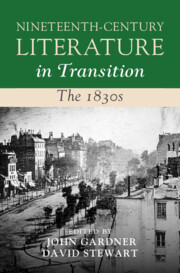Book contents
- Nineteenth-Century Literature in Transition: The 1830s
- Nineteenth-Century Literature in Transition
- Nineteenth-Century Literature in Transition: The 1830s
- Copyright page
- Contents
- Figures
- Contributors
- Acknowledgements
- Introduction
- Chapter 1 On the Eve
- Chapter 2 ‘An Infectious Madness’
- Chapter 3 Augustus Hardin Beaumont, Slavery Apologias, and Popular Radical Literature in the 1830s
- Chapter 4 Patterns of Industry
- Chapter 5 Mother Earth
- Chapter 6 The Polite Fictions of Slavery
- Chapter 7 Suffering, Sentiment, and the Rise of Humanitarian Literature in the 1830s
- Chapter 8 Steam and Iron in the 1830s
- Chapter 9 Lithography and the Comic Image 1825–1840
- Chapter 10 Jorrocks’s Canon
- Chapter 11 Tennyson, Dickens, Poe, Browning, and the Brontës:Blackwood’s Magazine and ‘The Foreheads of a New Generation’
- Chapter 12 Boz in London: The 1830s and the Urban Turn in the English Novel
- Chapter 13 Letitia Elizabeth Landon, Chronicler of the 1830s
- Chapter 14 Railway Imaginary in the 1830s
- Chapter 15 The Emerging Language of Photography
- Afterword
- Index
Chapter 10 - Jorrocks’s Canon
Dickens, Surtees, and 1830s Print Culture
Published online by Cambridge University Press: 30 May 2024
- Nineteenth-Century Literature in Transition: The 1830s
- Nineteenth-Century Literature in Transition
- Nineteenth-Century Literature in Transition: The 1830s
- Copyright page
- Contents
- Figures
- Contributors
- Acknowledgements
- Introduction
- Chapter 1 On the Eve
- Chapter 2 ‘An Infectious Madness’
- Chapter 3 Augustus Hardin Beaumont, Slavery Apologias, and Popular Radical Literature in the 1830s
- Chapter 4 Patterns of Industry
- Chapter 5 Mother Earth
- Chapter 6 The Polite Fictions of Slavery
- Chapter 7 Suffering, Sentiment, and the Rise of Humanitarian Literature in the 1830s
- Chapter 8 Steam and Iron in the 1830s
- Chapter 9 Lithography and the Comic Image 1825–1840
- Chapter 10 Jorrocks’s Canon
- Chapter 11 Tennyson, Dickens, Poe, Browning, and the Brontës:Blackwood’s Magazine and ‘The Foreheads of a New Generation’
- Chapter 12 Boz in London: The 1830s and the Urban Turn in the English Novel
- Chapter 13 Letitia Elizabeth Landon, Chronicler of the 1830s
- Chapter 14 Railway Imaginary in the 1830s
- Chapter 15 The Emerging Language of Photography
- Afterword
- Index
Summary
This chapter makes an argument that two of the most successful Victorian novelists, Charles Dickens and R. S. Surtees, those new men of the 1830s (Surtees was twenty-five when he begins Jorrocks’s Jaunts and Jollities; Dickens twenty-four at the conception of the Pickwick Papers), were both marked deeply by what came before in the late Georgian period’s popular-cultural print culture, notably its sporting comicalities. Though they took that tradition in very different paths – Surtees stayed in the sporting groove throughout his career, while Dickens very soon abandoned it – both were fashioned by it, and both initially positioned themselves within it. Both joined the key post-Napoleonic tradition of picaresque evident in the work of ‘Cockney’ humourists, in the fiction of Pierce Egan, and, indeed, in the poetry of Lord Byron. The chapter reads both men’s early writing against the wider context of late-Georgian print culture, addressing their relationship to the Romantic-era popular-cultural literary forms that inform their early work. The chapter brings to light this vibrant culture, focussing on Dickens and Surtees but also addressing such figures as Pierce Egan, Robert Seymour, and Thomas Hood.
- Type
- Chapter
- Information
- Nineteenth-Century Literature in Transition: The 1830s , pp. 218 - 240Publisher: Cambridge University PressPrint publication year: 2024

